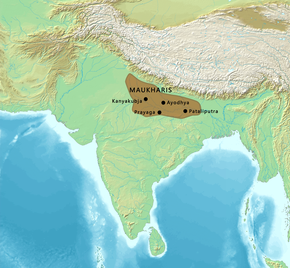
Back Maukhari Catalan Maŭĥaria dinastio Esperanto मौखरि वंश Hindi ಮೌಖರಿ Kannada 마우카리 왕조 Korean मौखरि वंश Marathi Maukharidynastie Dutch Maukhari NB موکھری خاندان PNB மௌகரி வம்சம் Tamil
Kingdom of Kanyakubja | |||||||||||||||
|---|---|---|---|---|---|---|---|---|---|---|---|---|---|---|---|
| c. 510 CE–c. 606 CE | |||||||||||||||
Coin of King Iśanavarman of the Maukhari of Kanyakubja, successors of the Guptas in the Gangetic region. Circa 535-553 CE. The ruler faces to the left, whereas in Gupta coinage the ruler faces to the right. This is possibly a symbol of antagonism and rivalry, as also seen on some similar coins of Toramana.[1] | |||||||||||||||
Map of Maukharis territory, with neighbouring polities, circa 550-600 CE, after the retreat of the Alchon Huns.[2] | |||||||||||||||
| Capital | Kanyakubja | ||||||||||||||
| Common languages | Sanskrit | ||||||||||||||
| Religion | Hinduism Buddhism | ||||||||||||||
| Government | Monarchy | ||||||||||||||
| Maharajadhiraja | |||||||||||||||
| Historical era | Classical India | ||||||||||||||
• Established | c. 510 CE | ||||||||||||||
• Disestablished | c. 606 CE | ||||||||||||||
| |||||||||||||||
The Maukhari dynasty (Gupta script: ![]() , Mau-kha-ri) was a post-Gupta dynasty who controlled the vast plains of Ganga-Yamuna for over six generations from their capital at Kanyakubja. Maukharis were Kshatriyas who belonged to the Chandravamsha or the Lunar race.[3] They earlier served as vassals of the Guptas and later of Harsha's Vardhana dynasty. The Maukharis established their independence during the mid 6th century. The dynasty ruled over much of Uttar Pradesh and Magadha. Around 606 CE, a large area of their empire was reconquered by the Later Guptas.[4] According to Hieun-Tsang, the territory may have been lost to King Shashanka of the Gauda Kingdom, who declared independence circa 600CE.[5][6]
, Mau-kha-ri) was a post-Gupta dynasty who controlled the vast plains of Ganga-Yamuna for over six generations from their capital at Kanyakubja. Maukharis were Kshatriyas who belonged to the Chandravamsha or the Lunar race.[3] They earlier served as vassals of the Guptas and later of Harsha's Vardhana dynasty. The Maukharis established their independence during the mid 6th century. The dynasty ruled over much of Uttar Pradesh and Magadha. Around 606 CE, a large area of their empire was reconquered by the Later Guptas.[4] According to Hieun-Tsang, the territory may have been lost to King Shashanka of the Gauda Kingdom, who declared independence circa 600CE.[5][6]
- ^ Tripathi, Rama S. (1989). History of Kanauj: To the Moslem Conquest. Motilal Banarsidass Publ. p. 45 Note 1. ISBN 978-81-208-0404-3.
- ^ Schwartzberg, Joseph E. (1978). A Historical atlas of South Asia. Chicago: University of Chicago Press. pp. 145, map XIV.1 (i), 25, 26. ISBN 0-226-74221-0.
- ^ Tandle, Dr Sanjeevkumar. INDIAN HISTORY. Lulu.com. ISBN 978-1-312-37211-5.
- ^ "Maukhari dynasty (Indian dynasty) - Britannica Online Encyclopedia". Britannica.com. Retrieved 2013-01-26.
- ^ Reza, Mohammad Habib; Bandyopadhyay, S.; Mowla, Azizul (July–September 2015). "Traces of Buddhist architecture in Gupta and post-Gupta Bengal: evidence from inscriptions and literature". Journal of Eurasian Studies. VII (3): 8–19. S2CID 163998400.[unreliable source?]
- ^ Dasgupta, Biplab (2005). European Trade and Colonial Conquest, Volume 1. Anthem Press. ISBN 978-1-84331-028-0. Retrieved 25 April 2020.
© MMXXIII Rich X Search. We shall prevail. All rights reserved. Rich X Search
![Coin of King Iśanavarman of the Maukhari of Kanyakubja, successors of the Guptas in the Gangetic region. Circa 535-553 CE. The ruler faces to the left, whereas in Gupta coinage the ruler faces to the right. This is possibly a symbol of antagonism and rivalry, as also seen on some similar coins of Toramana.[1] of](http://upload.wikimedia.org/wikipedia/commons/thumb/f/f7/Maukharis_of_Kanauj._Isanavarman._Circa_AD_535-553.jpg/250px-Maukharis_of_Kanauj._Isanavarman._Circa_AD_535-553.jpg)

